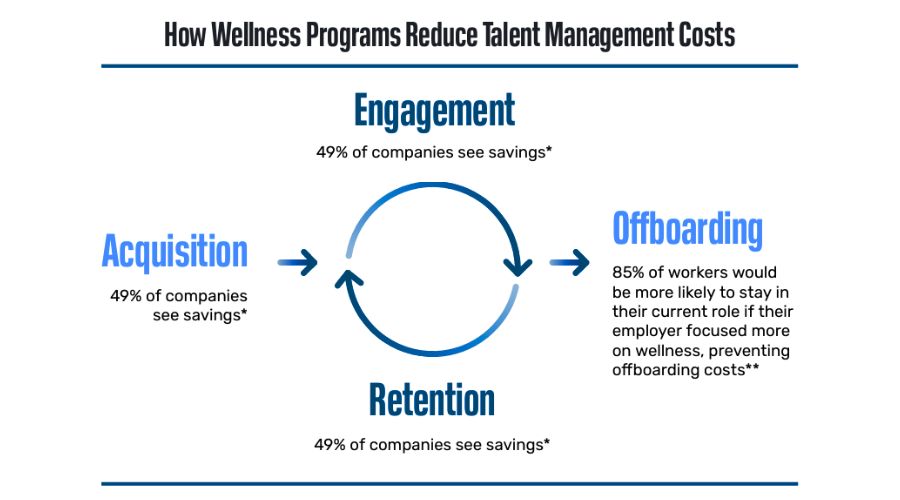Leaders are excited about wellness, but that enthusiasm doesn’t always translate into action. Despite all of the upsides C-suites see in these initiatives — from employee satisfaction to an increased competitive advantage — about half also view wellness programs as a fad in which they don’t see the value.
When leaders want to support wellbeing but are unconvinced wellness programs will have a lasting impact, it’s not surprising they may hesitate to invest. Wellbeing is imperative, so you want a solution you’re confident works.
Source: Human Resource Executive
How to Calculate the ROI of Your Wellness Program
If you feel overwhelmed at the idea of proving the financial ROI of a wellness program to your boss, you’re not alone. About one in five HR leaders, we surveyed say they can’t measure the return of their wellness initiative. But doing this doesn’t have to be intimidating!
There’s a straightforward formula you can use to quantify your return:

Measuring Employee Productivity
Productivity formulas are great ways to quantify employee output. These let you analyze how much value workers are producing for the company. While the variables utilized in such formulas vary industry-to-industry, the generic productivity formula is:
Productivity = output / input. Output can be determined by your company’s key performance indicators (KPIs), which are predefined benchmarks for employee performance and efficiency.
These focus on vital statistics, like clients served or units delivered. Your input will be company assets expended to create that output, like budget or employee time. Examples of useful productivity formulas include:
Revenue per employee. Take your revenue over the last 12 months and divide it by the number of full-time equivalent employees at the company. The result will let you know how much revenue is generated, on average, by one full-time worker.
Profit per employee. Also known as net income per employee (NIPE), find this figure by dividing your net income over the last twelve months by the number of full-time equivalent employees at your company. If you see your profit per employee increase after the implementation of a wellness program, that indicates the initiative could already be paying for itself.
Measuring Talent Management Savings
Competitive wellness perks attract new talent and lengthen employee tenure.

Candidate pipeline
Assess how many applicants you are receiving for your open job postings. This sum is the size of your candidate pipeline, or the number of workers interested in filing an opening at your company. Remember: 62% of workers say employee wellbeing is a deciding factor in whether or not they apply for a new job. Advertising your wellness program in job listings may increase the number of applicants you receive for each opening, which means you have a larger talent pool from which to hire.
Cost to hire
Research shows it costs six to nine months of an employee’s salary to replace them. This includes internal costs, such as staff time spent recruiting and referral bonuses, and external costs, like job posting fees and background checks. Wellness programs can reduce this cost by making your company more attractive to potential candidates, reducing the amount of staff salary that goes toward finding the right hire.
Turnover rate
To measure this, divide the number of employees who leave in a specified time period by the average number of employees at your organization during the same period. The rate of employees leaving your organization can drop as a result of a wellness program, as they often improve employee satisfaction and people are less likely to seek a new position when they are pleased with their current position.
Retention rate
Take the average number of employees during a given period, then subtract the number who left. Finally, divide by the average number of employees at your organization. Wellness programs can encourage employees to stick around by fostering a supportive, healthy culture of which people want to be a part.
Measuring Healthcare Savings
This is one of the most tangible measurements for capturing the success of your wellbeing program. The majority of North American employers save $3 in healthcare costs for every $1 they invest in a wellness program.
Health Costs
Insurance companies and providers typically send businesses quarterly or annual updates summarizing claims made on the organization’s policy. These reports are normally sent to the finance or human resource departments. These health care claims can give insight into:
Absenteeism and Injuries
If your employees are missing work more than usual due to sickness, stress, or mental health issues, a lack of workplace wellness is already impacting your organization and dragging down productivity.
Fatigue alone costs U.S. businesses an estimated $136.4 billion annually
Sick leave or health-related absenteeism
Employees, on average, use two to three paid sick days a year. If your organization’s rate is significantly higher, your employees would likely benefit from additional health support. It may also be beneficial to pay attention to the reasons behind the sick days taken. If illnesses are potentially linked to working conditions, this is another area in which improvements or wellness support could help the organization.
Wellness Program Costs
The full cost of running a wellness program will rely on a variety of factors, from rolling it out to maintaining the initiative and measuring its impacts. Some of the expenditures you’ll want to keep in mind include:
Administration expenditures
The time your department puts into planning, promoting, and overseeing these programs is valuable. Estimate how many hours a program will take to oversee to evaluate how much it will cost the company in staff time.
Ongoing expenses
Consider payments you will need to make on a recurring basis for extended wellness programs, like offering gym membership reimbursements, subscriptions to mental wellness apps, or a steady monthly wellbeing program outsourced to an external provider.


